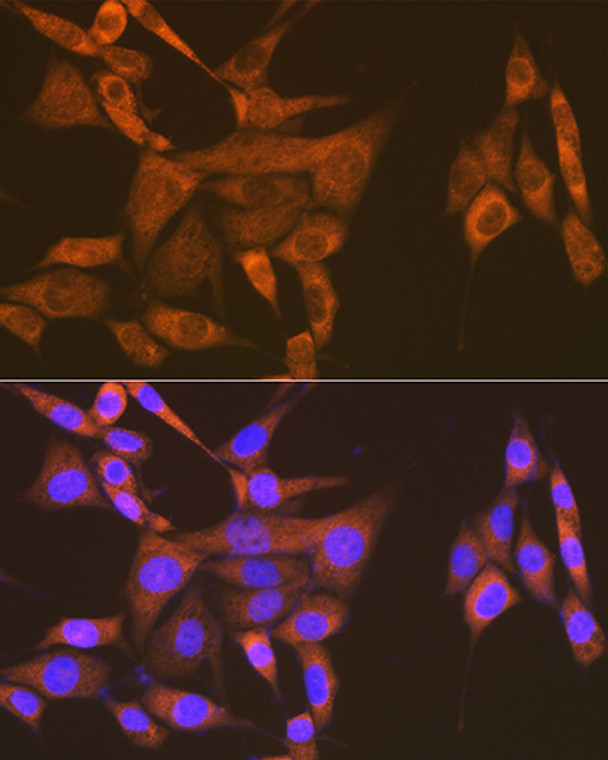| Host: |
Rabbit |
| Applications: |
WB/IHC/IF |
| Reactivity: |
Human/Mouse/Rat |
| Note: |
STRICTLY FOR FURTHER SCIENTIFIC RESEARCH USE ONLY (RUO). MUST NOT TO BE USED IN DIAGNOSTIC OR THERAPEUTIC APPLICATIONS. |
| Short Description: |
Rabbit monoclonal antibody anti-USP9x (1-100) is suitable for use in Western Blot, Immunohistochemistry and Immunofluorescence research applications. |
| Clonality: |
Monoclonal |
| Clone ID: |
S8MR |
| Conjugation: |
Unconjugated |
| Isotype: |
IgG |
| Formulation: |
PBS with 0.02% Sodium Azide, 0.05% BSA, 50% Glycerol, pH7.3. |
| Purification: |
Affinity purification |
| Dilution Range: |
WB 1:500-1:1000IHC-P 1:50-1:200IF/ICC 1:50-1:200 |
| Storage Instruction: |
Store at-20°C for up to 1 year from the date of receipt, and avoid repeat freeze-thaw cycles. |
| Gene Symbol: |
USP9X |
| Gene ID: |
8239 |
| Uniprot ID: |
USP9X_HUMAN |
| Immunogen Region: |
1-100 |
| Immunogen: |
A synthetic peptide corresponding to a sequence within amino acids 1-100 of human USP9X (Q93008). |
| Immunogen Sequence: |
MTATTRGSPVGGNDNQGQAP DGQSQPPLQQNQTSSPDSSN ENSPATPPDEQGQGDAPPQL EDEEPAFPHTDLAKLDDMIN RPRWVVPVLPKGELEVLLEA |
| Tissue Specificity | Widely expressed in embryonic and adult tissues. |
| Function | Deubiquitinase involved both in the processing of ubiquitin precursors and of ubiquitinated proteins. May therefore play an important regulatory role at the level of protein turnover by preventing degradation of proteins through the removal of conjugated ubiquitin. Specifically hydrolyzes 'Lys-63'-, 'Lys-48'-, 'Lys-29'- and 'Lys-33'-linked polyubiquitins chains. Essential component of TGF-beta/BMP signaling cascade. Specifically deubiquitinates monoubiquitinated SMAD4, opposing the activity of E3 ubiquitin-protein ligase TRIM33. Deubiquitinates alkylation repair enzyme ALKBH3. OTUD4 recruits USP7 and USP9X to stabilize ALKBH3, thereby promoting the repair of alkylated DNA lesions. Deubiquitinates mTORC2 complex component RICTOR at 'Lys-294' by removing 'Lys-63'-linked polyubiquitin chains, stabilizing RICTOR and enhancing its binding to MTOR, thus promoting mTORC2 complex assembly. Regulates chromosome alignment and segregation in mitosis by regulating the localization of BIRC5/survivin to mitotic centromeres. Involved in axonal growth and neuronal cell migration. Regulates cellular clock function by enhancing the protein stability and transcriptional activity of the core circadian protein BMAL1 via its deubiquitinating activity. Acts as a regulator of peroxisome import by mediating deubiquitination of PEX5: specifically deubiquitinates PEX5 monoubiquitinated at 'Cys-11' following its retrotranslocation into the cytosol, resetting PEX5 for a subsequent import cycle. Deubiquitinates PEG10. |
| Protein Name | Probable Ubiquitin Carboxyl-Terminal Hydrolase Faf-XDeubiquitinating Enzyme Faf-XFat Facets In MammalsHfamFat Facets Protein-Related - X-LinkedUbiquitin Thioesterase Faf-XUbiquitin-Specific Protease 9 - X ChromosomeUbiquitin-Specific-Processing Protease Faf-X |
| Database Links | Reactome: R-HSA-2173795Reactome: R-HSA-5689880Reactome: R-HSA-8866652Reactome: R-HSA-9013420Reactome: R-HSA-9013424Reactome: R-HSA-9033241Reactome: R-HSA-977225 |
| Cellular Localisation | CytoplasmCytosolCell ProjectionGrowth ConeCytoskeletonCilium Axoneme |
| Alternative Antibody Names | Anti-Probable Ubiquitin Carboxyl-Terminal Hydrolase Faf-X antibodyAnti-Deubiquitinating Enzyme Faf-X antibodyAnti-Fat Facets In Mammals antibodyAnti-Hfam antibodyAnti-Fat Facets Protein-Related - X-Linked antibodyAnti-Ubiquitin Thioesterase Faf-X antibodyAnti-Ubiquitin-Specific Protease 9 - X Chromosome antibodyAnti-Ubiquitin-Specific-Processing Protease Faf-X antibodyAnti-USP9X antibodyAnti-DFFRX antibodyAnti-FAM antibodyAnti-USP9 antibody |
Information sourced from Uniprot.org
12 months for antibodies. 6 months for ELISA Kits. Please see website T&Cs for further guidance












![Immunoprecipitation analysis of 600 Mu g extracts of 293T cells using 3 Mu g [KD Validated] CDX2 Rabbit monoclonal antibody (STJ11101568). Western blot was performed from the immunoprecipitate using CDX2 antibody (STJ11101568) at a dilution of 1:500. Immunoprecipitation analysis of 600 Mu g extracts of 293T cells using 3 Mu g [KD Validated] CDX2 Rabbit monoclonal antibody (STJ11101568). Western blot was performed from the immunoprecipitate using CDX2 antibody (STJ11101568) at a dilution of 1:500.](https://cdn11.bigcommerce.com/s-zso2xnchw9/images/stencil/300x300/products/90481/359933/STJ11101568_1__84936.1713124490.jpg?c=1)

